Russell Brice points the finger
He kept silent for weeks, but now he has found very clear words. “This is my 20th year of operations for Himalayan Experience but never before have I experienced such a variety of emotions as I did this year” writes Russell Brice at the beginning of a five-part series of reports about what happened on and around Mount Everest this spring. At this point I can only sum up the content but you should really take time to read Russell’s first hand reports in its full length. The owner and expedition operator from New Zealand was at Everest Base Camp when the devastating avalanche went down over the Khumbu Icefall and killed 16 Nepalese climbers on 18 April. “It appears that there was already a traffic jam in this area at the time of the avalanche, so it is not surprising that there were so many killed and injured.”
![]() read more
read more
End of an Everest dream
Failure is hard, even for a climber who is up to every trick in the mountains. „I’m not satisfied“, Ralf Dujmovits admits. On Monday he arrived safely back in Advanced Base Camp ABC) at 6400 meters. But what happened to him on Saturday in Camp 3 will probably captivate him for a long time. „I really felt fine all the way up to 8300 meters. But then within half an hour everything changed“, Ralf told me on Monday. The uneven ground, the white frost on the inside of the single-walled tent which melted, dripped down and made everything wet, including his lighter. „It just threw me off course that I could no longer melt snow.“
I ask the 52-year-old whether everything would have been different if he had chosen another tent for Camp 3. „It’s possible. But I chose the lightweight tent because I wanted to reduce the weight as much as possible“, Ralf answers. „If you can carry more, you surely take a different tent.“ And if he had found a better place for his tent? „Then perhaps it would have been different.“ If and would and when, pure speculation. „I ‘m not the kind of man who blames everything on the external circumstances. I am also self-critical“, says Dujmovits. „It was just the way it was.“
![]() read more
read more
Double fault stops Dujmovits on Everest
Ralf Dujmovits is annoyed. More about himself than about the fact that his dream to climb Mount Everest without bottled oxygen has disappeared. At 8300 meters, Germany’s most successful high-altitude climber decided not to start to the 8850-meter-high summit but to turn around. “I have performed badly”, says Ralf when he calls me by satellite phone from Camp 2 at 7700 meters. “I made a double fault.”
![]() read more
read more
Summit successes on Everest, Dujmovits at 8300 meters
The first climbers came from the south. On Friday evening local time, the Chinese Wang Jing and five Sherpas reached the summit of Mount Everest via the Nepalese normal route. However, I hesitate to call it a complete ascent. The team had been flown by helicopter to Camp 2 at 6400 meters after the “Ice doctors” had stopped to maintain the route through the Khumbu Icefall. After the avalanche disaster on 18 April – as reported – all commercial expeditions on the Nepalese side of the mountain had been cancelled.
Today the first summit successes were also reported from the Tibetan north side. A team of 15 climbers of the Russian expedition organizer “7SummitsClub” reached the highest point at 8850 meters during snowfall and wind. The German climber Ralf Dujmovits had to struggle with these difficult weather conditions too when he ascended from Camp 2 at 7700 meters to Camp 3 at 8300 meters.
![]() read more
read more
Ralf Dujmovits’ summit bid is on
The time has come. Ralf Dujmovits, Germany’s most successful high-altitude climber, has started his summit attempt on the Tibetan north side of Mount Everest. On Thursday, he climbed up to the North Col at 7000 meters, today to Camp 2 at 7700 meters. There – as reported previously – he had deposited a material bag. “The wind has blown strongly, I had trouble to pitch my tent”, says Ralf when he calls me by satellite phone from Camp 2. “But now the tent is ready, I have cooked and eaten.” The 52-year-old is targeting Sunday as summit day, the weather forecast so far promises for 25 May good conditions with relatively little wind.
On Saturday, Ralf wants to climb up to an altitude of about 8300 meters. He will leave his tent at Camp 2 and pitch at Camp 3 a mini tent that he had already used on Aconcagua at the end of 2013. The traffic on the normal route keeps within limits, reports Dujmovits. “Some climbers want to reach the highest point on 24 May. Thus the whole thing is equalized. On Sunday, 40 to 45 climbers might start to the summit. If you consider that the entire season is focusing on this weekend, these are quite a few. So far, I have not seen anyone who is climbing without oxygen, apart from me.” Everything is served. And Ralf seems to be optimistic: “I’m in good shape and make good progress.”
Update: A Hungarian blog user told me that his compatriot David Klein is also climbing without bottled oxygen and has already reached Camp 3.
Update II: According to a press release of the Nepalese tourism ministry the Chinese female climber Wang Jing and five Sherpas have summited Mount Everest from the south side of the mountain. As reported, the team had been flown by helicopter to Camp 2 and had started the ascent from there.
Dujmovits decides to take Everest normal route, “though it pains me”
“It would have been a dream to take this beautiful route, but I do not dare to climb in this crumbly zone.” Ralf Dujmovits sounds a little bit disappointed when he calls me via satellite phone from the Advanced Base Camp (ABC) on the Tibetan north side of Mount Everest. Actually, the 52-year-old wanted to scale Everest via the route that Reinhold Messner had opened during his solo ascent in 1980: beneath the North Ridge, then through the upper part of the Norton Couloir, onto the summit plateau. The wind was the reason that he abandoned his plan, explains Ralf: “It is blowing for 14 days now. There is a rocky interruption in the upper section of the Norton Couloir, where it is the steepest. There is no snow, probably it is rather sandy.” Even the point where Messner had left the couloir is free of snow now. This challenge at an altitude of more than 8000 meters is too big for him, because he will be climbing alone and without bottled oxygen, says Ralf. “This is too difficult, too exciting. I’m getting older, I have not enough power for that.” Now he will try to climb to the summit on the normal route, “though it pains me”.
![]() read more
read more
German doctor wants to help Sherpa families in the long term
18 April has changed many things: on Mount Everest, in the lives of the families of the 16 avalanche victims – and also for Matthias Baumann. The 42-year-old trauma surgeon from the German town of Esslingen was the expedition doctor in the team of the Argentine twin brothers Damian and Willie (Guillermo) Benegas and actually wanted to climb Everest in his second attempt, on the Nepalese south side. In 2011, his first attempt on the Tibetan north side had failed at 8600 meters: When he wanted to change his oxygen bottle at the Second Step, the key point of the normal route, Matthias realized that his Sherpa had packed an empty instead of a full bottle.
Three years later, this spring, Baumann climbed through the Khumbu Icefall, on the day before the avalanche. “I knew that avalanches had been coming down from the West Shoulder of Everest for four or five years. Up there, the seracs are threatening”, Matthias told me. Even if the fun at climbing gained the upper hand, the respect remained. “I was always looking up to the seracs.” On the following day, the Khumbu Icefall became a death trap for 16 Nepalese climbers. With other physicians, the German doctor took care of the injured climbers who were brought down to the base camp. After the end of the expedition Matthias visited almost all the families of the Nepalese who had lost their lives – and launched a fundraiser for them.
![]() read more
read more
End of the season on Everest? Two women say: No!
Is there still some climbing possible on the Nepalese side of Mount Everest? The “Himalayan Times” reported that the Chinese female climber Wang Jing was with seven Sherpas on the way to base camp. The 40-year-old wanted to climb the highest mountain on earth. Wang was already once on the summit of Everest, on 22 May 2010, becoming the first Chinese woman who climbed the mountain from the south side. In her home country she is a star. Wang has written a book about her mountaineering and is leading an outdoor outfitter in Beijing. Everest is part of her “Project 7+2”. She wants to scale the “Seven Summits”, the highest peaks of all continents, in record time and in addition reach the North and the South Pole.
![]() read more
read more
Help for families of avalanche victims on Everest
Waiting for the calm after the storm. Currently the wind is blowing strongly in the summit region of Mount Everest – with speeds up to 60 knots (about 110 km per hour). A summit attempt of one of the about ten teams on the Tibetan north side of the mountain is out of question. Not until 16 May a good weather window with low wind is expected. On the south side of Everest, according to the U.S. expedition leader Eric Simonsen, the “Icefall doctors” brought down their ladders and ropes from the Khumbu Icefall. Until next season, the material is deposited in a storage in Gorak Shep, the last permanently inhabited small village near Mount Everest at 5200 meters. Thus there will be definitely no climb to the 8850-meter-high summit from the Nepalese side this spring. This week in Kathmandu, the Japanese climber Ken Noguchi presented on behalf of his environmental protection organization “Seven Summits Actions for Sustainable Society” a donation of $ 100,000 to Ang Tshering Sherpa, president of the Nepal Mountaineering Association (NMA).
![]() read more
read more
News from the North (of Everest)
It is time to look to the north side of Mount Everest. After the early end of the spring season on the Nepalese south side because of the avalanche accident in the Khumbu Icefall with 16 dead, everything is proceeding on schedule on the Tibetan side of Everest. About 100 climbers have got a permit of the China Tibet Mountaineering Association (CTMA) to climb on the north side of the highest mountain in the world. The members of an expedition from Malta have already climbed to Camp 2 on 7500 meters by mid-week. “We need to wait for our summit window”, expedition leader Greg Attard reported. “The team is performing very well. Everyone is exhausted but excited and in good health.”
![]() read more
read more
Goettler: Violent Sherpas poison atmosphere on Everest
More than 300 Everest dreams are gone. As many climbers returned home empty-handed after their expeditions had been cancelled after the avalanche in the Khumbu Icefall on Good Friday. One of them was David Goettler. The 35-year-old from the German town of Munich had wanted to climb the highest mountain in the world via the normal route on the Nepalese south side without bottled oxygen. Goettler was still acclimatizing when he heard the first still inconsistent reports about the avalanche. “Initially, I hoped that I might still be able to make an attempt”, David told me on the phone. Therefore, he first continued his acclimatization program. “But when I was on the summit of Island Peak (6000er in the Everest region) and wanted to sleep below the highest point, the news came that my expedition and all others would be cancelled.” He returned to Kathmandu.
![]() read more
read more
Quo vadis, Everest?
The avalanche in the Khumbu Icefall on Good Friday could be a decisive turning point in the history of Mount Everest. For the first time since the start of commercial expeditions to the highest mountain in the world in the late 1980s there will be almost certainly no clients who reach the summit via the Nepalese south side this spring. The season is over, not officially, but de facto. All major expedition teams have left the base camp, many climbers have meanwhile arrived in Kathmandu. There are more and more reports about massive threats of a small group of Sherpas against those compatriots who wanted to stay on the mountain despite the avalanche disaster with 16 deaths. Western climbers were apparently threatened too.
![]() read more
read more
The gradual end of the Everest season in Nepal
The base camp on the Nepalese side of Mount Everest is getting empty. Government officials denied that the climbing season on the highest mountain in the world was officially ended. “The ones who want to leave will leave and those who want to continue climbing would not be stopped or threatened,” said Tourism Minister Bhim Acharya after a crisis meeting at the basecamp, where he had tried to convince the teams to continue the expeditions. The Sherpas had assured him that there would be no trouble, he said.
![]() read more
read more
Everest boycott or going on?
One crisis meeting leads to another, at Everest basecamp at 5300 meters as well as at the seat of the Nepalese government in Kathmandu. It is still unclear whether there will be attempts to climb the highest mountain in the world via the Nepalese south side this spring. “Most teams are leaving the basecamp. They are afraid that something will happen (many avalanches are still coming down), but also that other Sherpas could punish them for going on”, German reporter Juliane Moecklinghoff, who accompanies the blind Austrian climber Andy Holzer, writes in her Everest diary. “There have been several meetings among the various team leaders, Sirdars and Sherpas but it remains unclear what the final decision will be”, reports Eric Simonson of the expedition organizer International Mountain Guides (IMG). Since the avalanche in the Khumbu Icefall last Friday killed 16 Nepalis, all mountain activities have been resting.
![]() read more
read more
Shock and anger on Mount Everest
 “It‘s a tremendous shock to us all“, Dawa Steven Sherpa writes to me from the basecamp on the Nepalese side of Mount Everest. “My team was extremely lucky to miss the avalanche but we have all lost friends and family members in the avalanche.” As in the previous years the 30-year-old Nepalese is leading an “Eco Everest Expedition” which is combining business and ecology: clients are led to the 8850-meter-high summit, but the team is also collecting garbage and brings it down to the valley.
“It‘s a tremendous shock to us all“, Dawa Steven Sherpa writes to me from the basecamp on the Nepalese side of Mount Everest. “My team was extremely lucky to miss the avalanche but we have all lost friends and family members in the avalanche.” As in the previous years the 30-year-old Nepalese is leading an “Eco Everest Expedition” which is combining business and ecology: clients are led to the 8850-meter-high summit, but the team is also collecting garbage and brings it down to the valley.
It is still unclear when the climbing season on Everest will continue – and if at all. Alpine Ascents International (AAI) is the first of the big Everest players that has called off its expedition. “We have all agreed the best thing is to not continue this season’s climb, so that all can mourn the loss of family, friends and comrades in this unprecedented tragedy”, AAI writes on its website. Among the 16 avalanche victims of last Friday were five Sherpas working for AAI. They also supported the U.S. climber Joby Ogwyn, who planned to make the first wingsuit flight from the summit of Everest. Discovery Channel has meanwhile cancelled the live TV broadcast of the jump that was originally planned for 11 May. The team of Adventure Consultants that had lost three members in the avalanche has also decided to go home.
![]() read more
read more



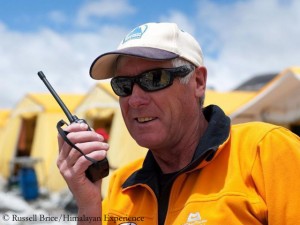

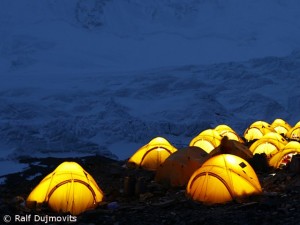
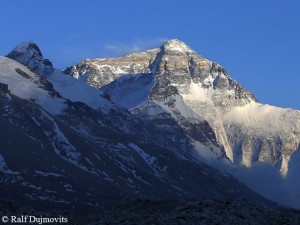
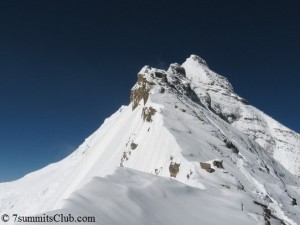
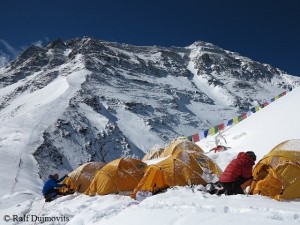
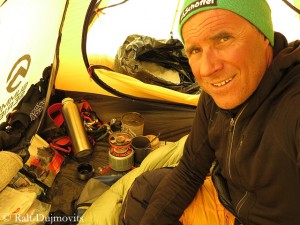
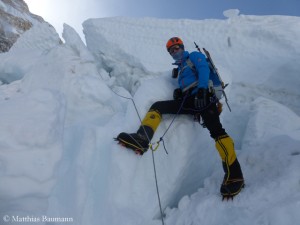
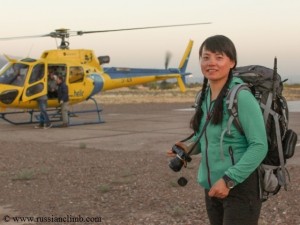
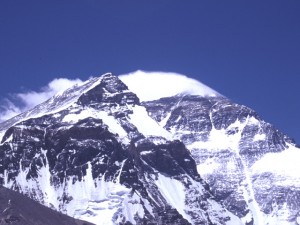
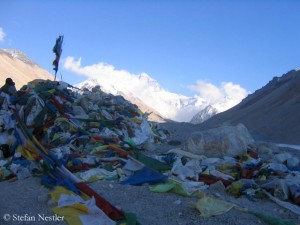

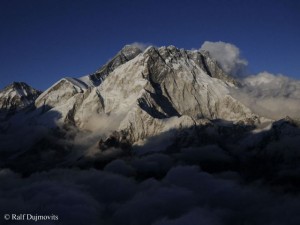
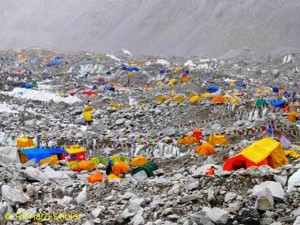
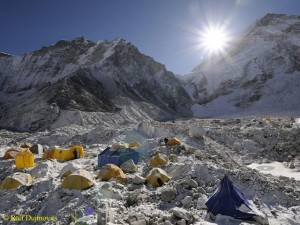





Feedback